Summer meteor showers are here
It’s summer meteor time! The Delta Aquariid meteors ramble across the sky for weeks from late July through early August. They blend in with the famous Perseid meteor show, that will peak around the morning of August 12, 2024. How can you optimize your chances of seeing a great meteor display? Follow these tips.
Late July through early August: Delta Aquariid meteor shower
The Delta Aquariid meteor shower doesn’t have a noticeable peak. It rambles along steadily from late July through early August, joining forces with the August Perseids. The radiant – the point where the meteors seem to originate – is highest in the sky at 2 a.m.
Here’s a 1-minute preview video of the Delta Aquariid meteor shower.
July moon
The moon is now in a waning gibbous phase. That means it’ll rise an hour or so after sunset. And it’ll be rising later – and later – in the coming evenings. Here’s a 1-minute video preview of the moon phases for the month of July 2024. See when it’ll be near visible planets, bright stars and star clusters.
July 28: Last quarter moon
The instant of last quarter moon will fall at 2:52 UTC on July 28, 2024 (9:52 p.m. CDT on July 27). It’ll rise after midnight your local time and will set around noon. Look for it high in the sky before dawn.
July 29 to 31 evenings: Mercury and Venus
Venus will hang low in the west about 30 minutes after sunset on the last few evenings of July. Tiny Mercury will lie near Venus as well. Look for them in the bright evening twilight. Venus sets about 50 minutes after the sun.
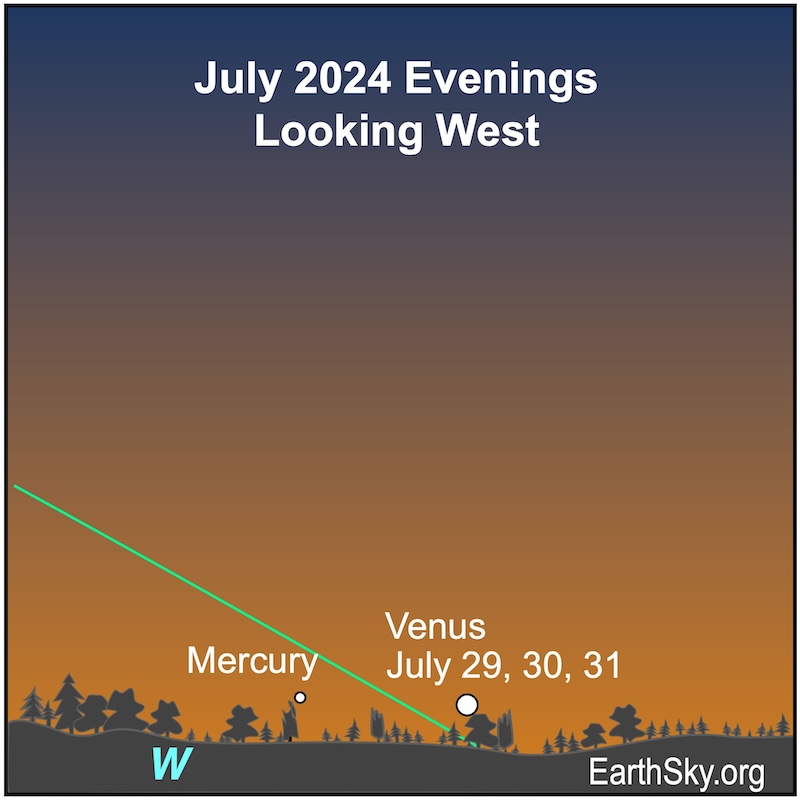
Our charts are mostly set for the northern half of Earth. To see a precise view – and time – from your location, try Stellarium Online.
July 29 and 30 mornings: Moon near Mars, Jupiter and Pleiades
Try to see this eye-catching sight! On July 29, 2024, the waning crescent moon will lie close to the glimmering Pleiades star cluster. The reddish planet Mars will lie nearby. On the morning of July 30, the moon, Jupiter, Mars and Aldebaran will form a rectangle in the morning sky. You can see them before dawn.
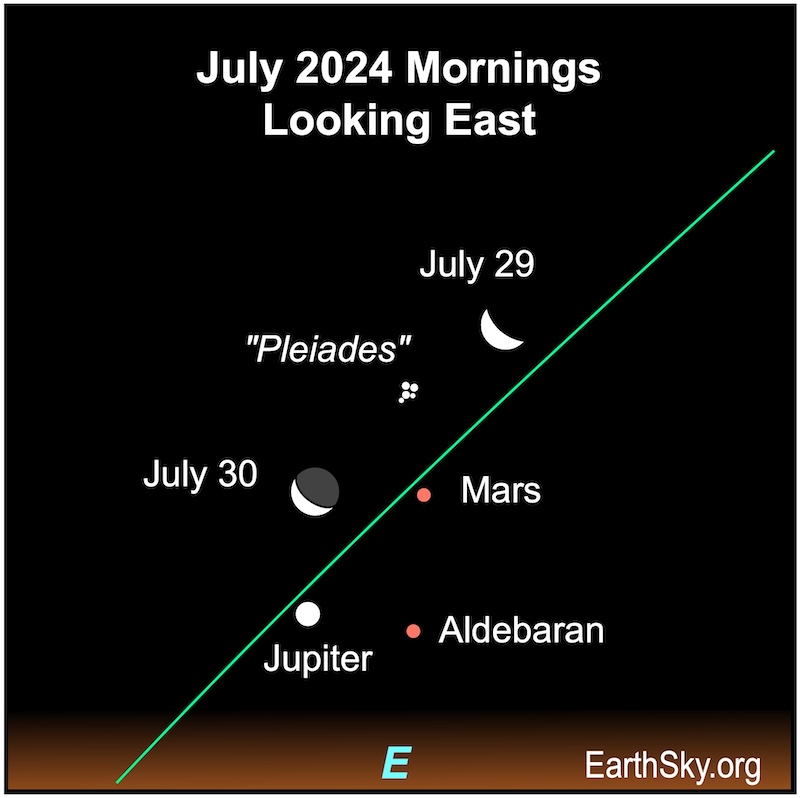
July 31 morning: Moon near Mars, Jupiter and Pleiades
July finishes with a grand sight in the morning sky. On July 31, 2024, the waning crescent moon will lie between two bright stars: Capella and Betelgeuse. Capella is in the constellation Auriga the Charioteer. Betelgeuse is the red supergiant star in Orion the Hunter. Also, look for Jupiter, Mars and the fiery star Aldebaran. Don’t forget to look for earthshine. It’s reflected light from Earth that illuminates the unlit portion of a crescent moon. You can see them before dawn.
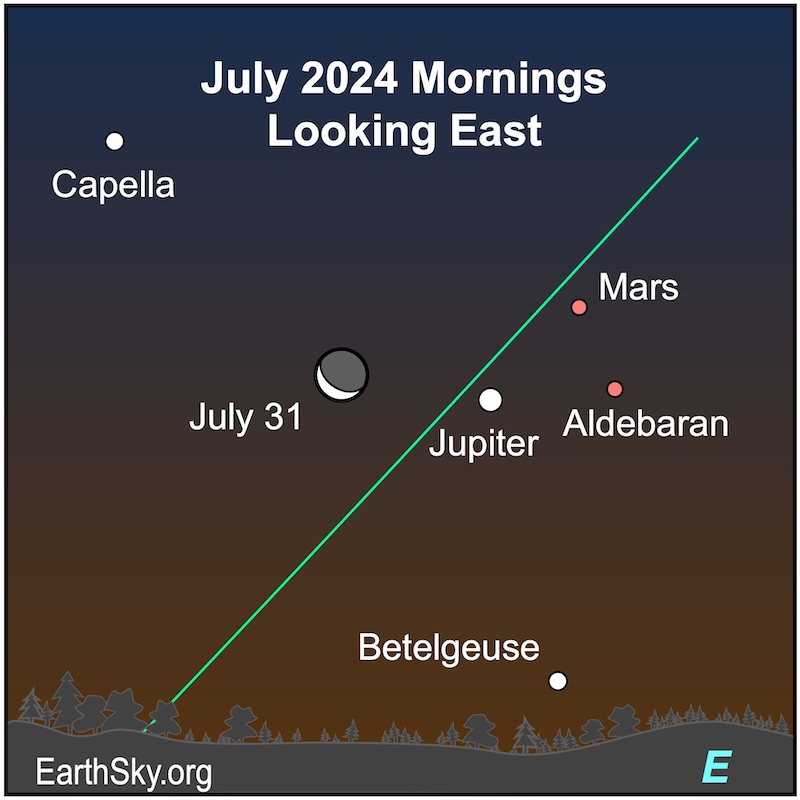
Our charts are mostly set for the northern half of Earth. To see a precise view – and time – from your location, try Stellarium Online.
August 1 morning: Moon near Jupiter and Mars
On the first morning of August, the waning crescent moon will rise after Jupiter and Mars. Nearby will be the bright stars: Capella, Betelgeuse and Aldebaran. Capella is in the constellation Auriga the Charioteer. Betelgeuse is the red supergiant star in Orion the Hunter. Aldebaran is the fiery eye of Taurus the Bull. You can see them starting a few hours before dawn.
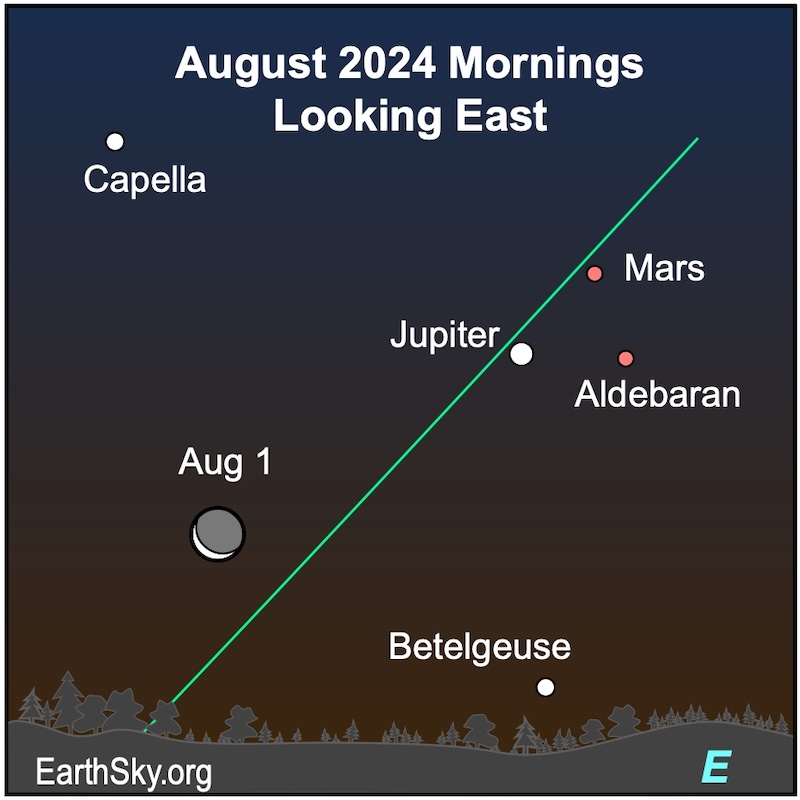
August 2 and 3 mornings: Moon near Castor and Pollux
On the mornings of August 2 and 3, 2024, the thin waning crescent moon will slide by Castor and Pollux, the “twin” stars of Gemini. They don’t look like identical twins. Pollux is a bit brighter and golden in color. Castor appears white. The dark portion of the moon will be glowing with earthshine. That’s reflected light from the Earth. The moon will rise about two hours before sunrise.
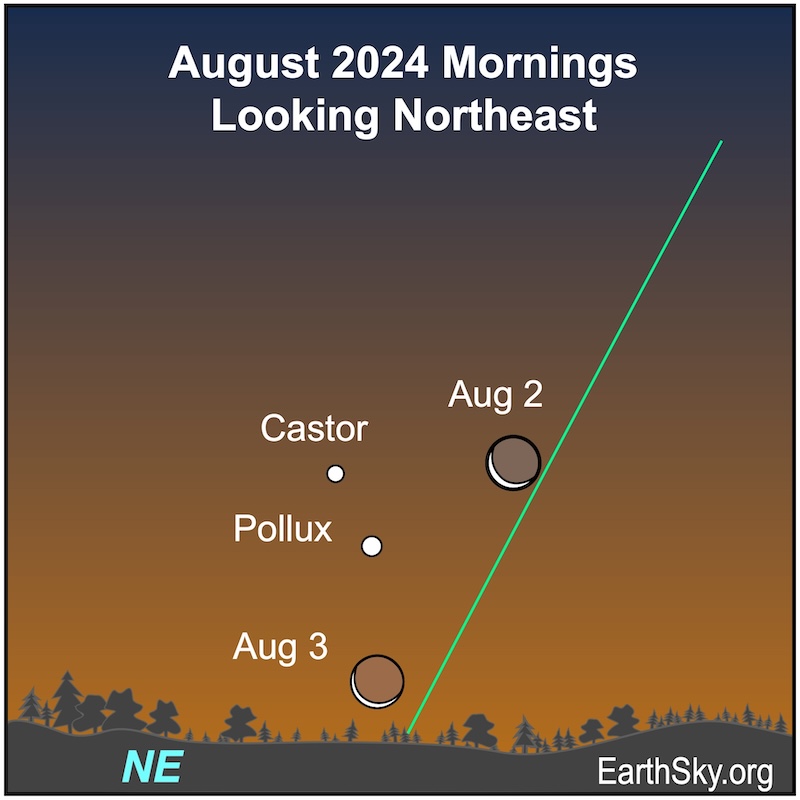
August 4: New moon
The moment of new moon will fall at 11:13 UTC (6:13 a.m. CDT) on August 4, 2024. Nights around the new moon are perfect for stargazing under dark skies. If you’re out under dark skies, look for a summer favorite – the Perseus Double cluster – that appears as a smudge on the sky between the constellations of Cassiopeia and Perseus.
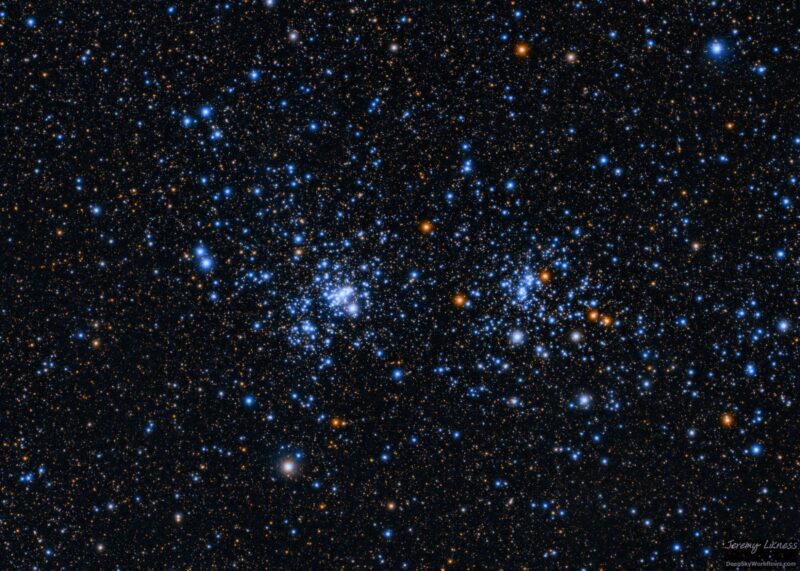
Our charts are mostly set for the northern half of Earth. To see a precise view – and time – from your location, try Stellarium Online.
August 5 and 6 evenings: Moon near Venus
About 30 minutes after sunset on the evening of August 5, 2024, the thin waxing crescent moon will hang close to Venus in the evening twilight. Then on the following evening, August 6, 2024, the lit portion of the crescent moon will point to brilliant Venus. Venus is just beginning to ascend in the evening sky and will reach its greatest distance from the sun in January 2025. Look for a lovely glow on the unlit side of the moon. That’s earthshine! It’s reflected light from Earth.
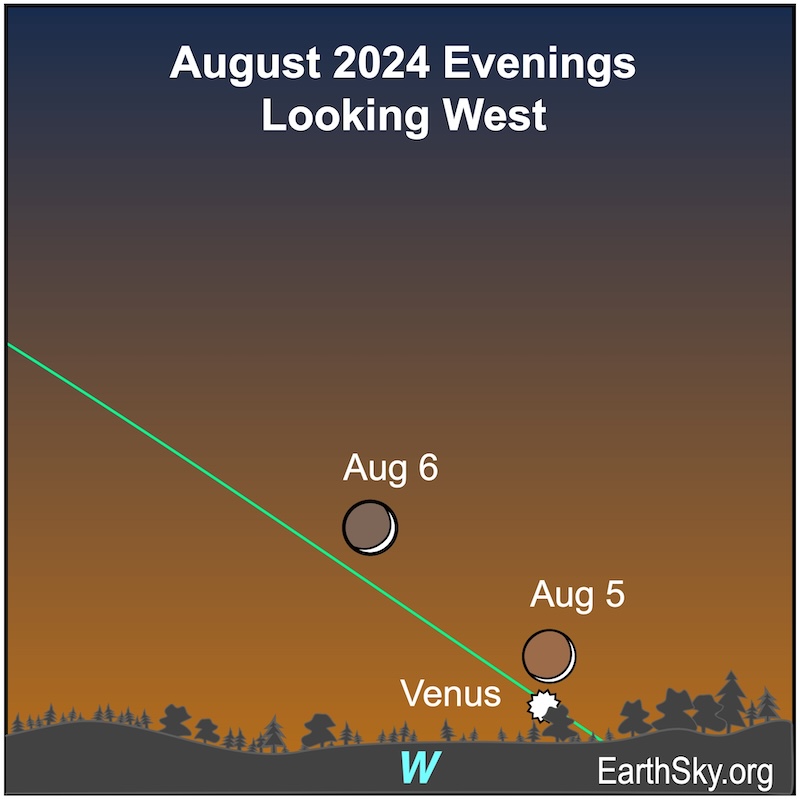
August 9: Moon reaches apogee
The moon will reach apogee – its farthest distance from Earth in its elliptical orbit around Earth – at 2 UTC on August 9, 2024, when it’s 251,839 miles (405,297 km) away.
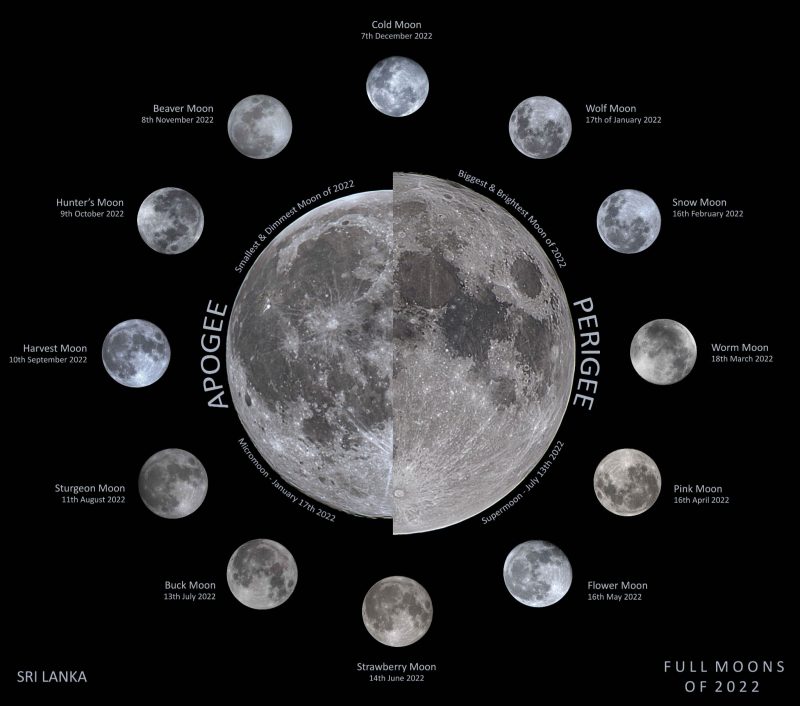
August 9 and 10 evenings: Moon near Spica
On the evenings of August 9 and 10, 2024, the waxing crescent moon will lie near the bright star Spica in Virgo the Maiden. They’ll rise before sunset and be visible until after 10 p.m. your local time. Locations including eastern Europe, western Russia, most of Asia, northern Indonesia, southern Japan and western Micronesia will see the moon pass in front of – or occult – Spica around 10 UTC on August 10. Others may see Spica close to the limb (edge) of the moon.
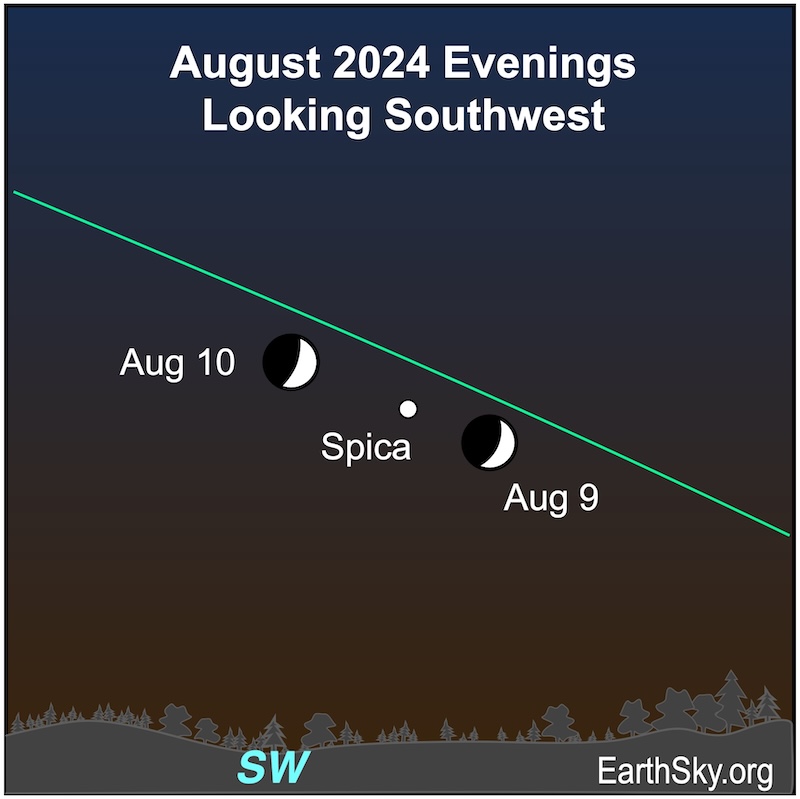
Around August 12: Perseid meteor shower
The Perseid meteor shower will peak around the mornings of August 12, 2024. The moon will be at 1st quarter and 50% illuminated, so the best time to watch for Perseids will be starting around midnight until dawn.
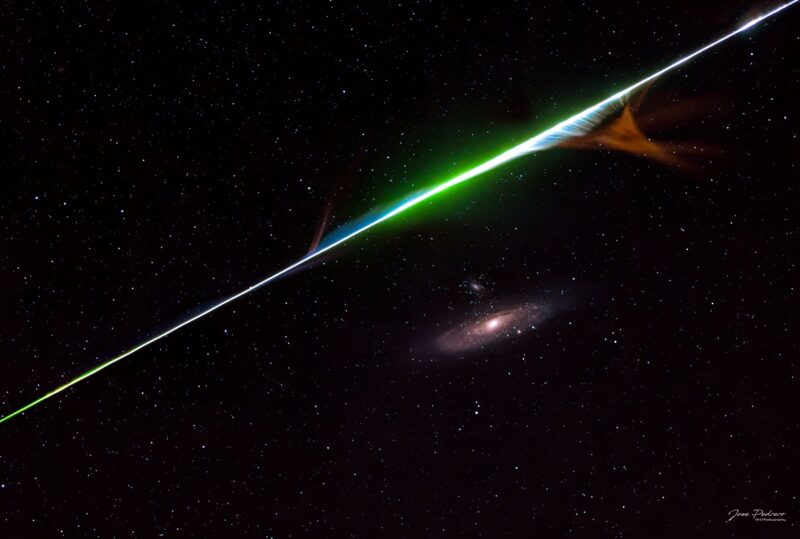
Our charts are mostly set for the northern half of Earth. To see a precise view – and time – from your location, try Stellarium Online.
August 12: 1st quarter moon
The moment of 1st quarter moon will fall at 15:19 UTC (10:19 a.m. CDT) on August 12, 2024. A 1st quarter moon rises around noon your local time and sets around midnight. Watch for it high in the sky at sundown.
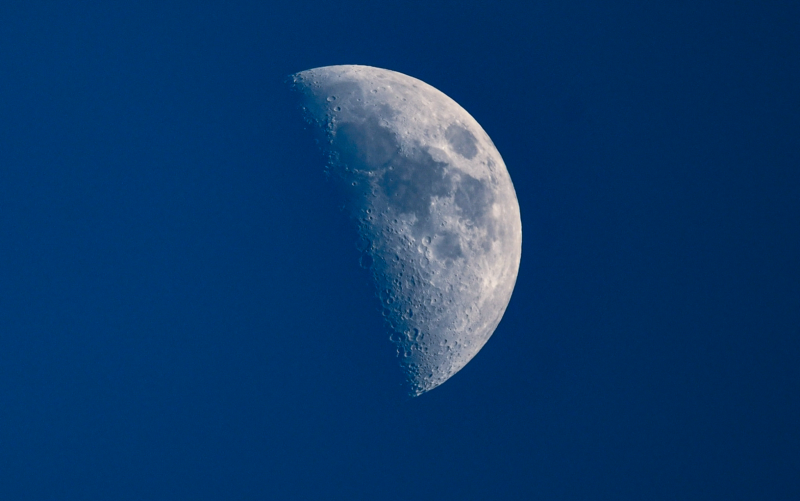
August 13-16 mornings: Binocular view of Jupiter and Mars
Jupiter and Mars will shine in the eastern morning sky in the month of August. On the morning of August 14, they will lie closest to each other when they pass less than a full moon-width apart. Here’s a binocular view of the planetary pair around August 14.
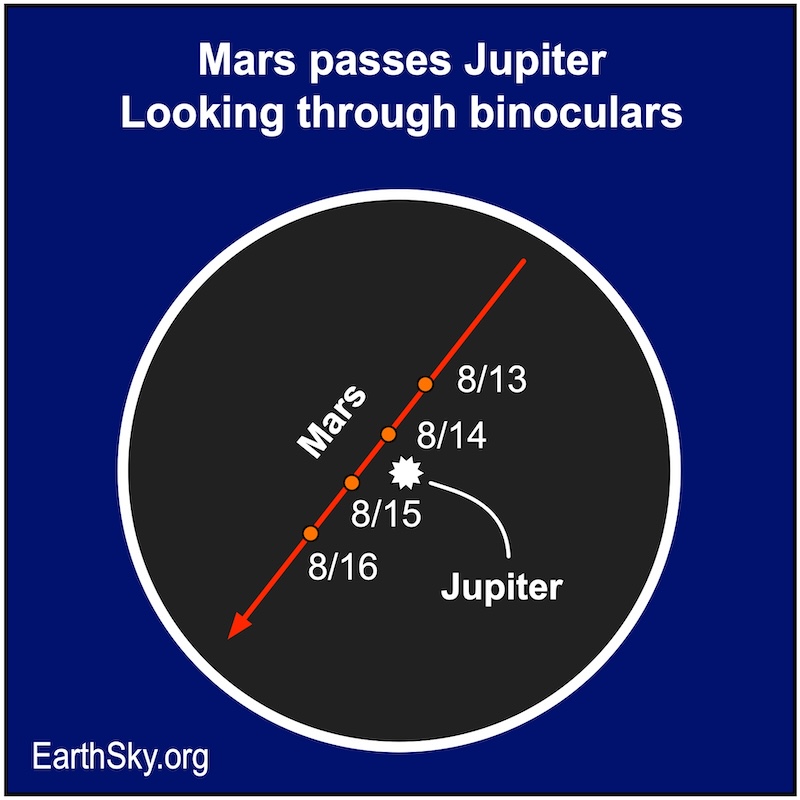
August 13 evening: Moon lies near Antares
On August 13, 2024, the bright red star Antares in Scorpius the Scorpion will lie close to the growing waxing gibbous moon. Also, sky watchers in locations including French Polynesia, Cook Islands, Galapagos Islands and Pitcairn will see the moon pass in front of – or occult – Antares near 5 UTC on August 14. Other locations may see Antares very close to the limb (edge) of the moon. The star may be difficult to spot because of the brightness of the moon. Position yourself so the moon lies behind a utility pole and the star will pop into view!
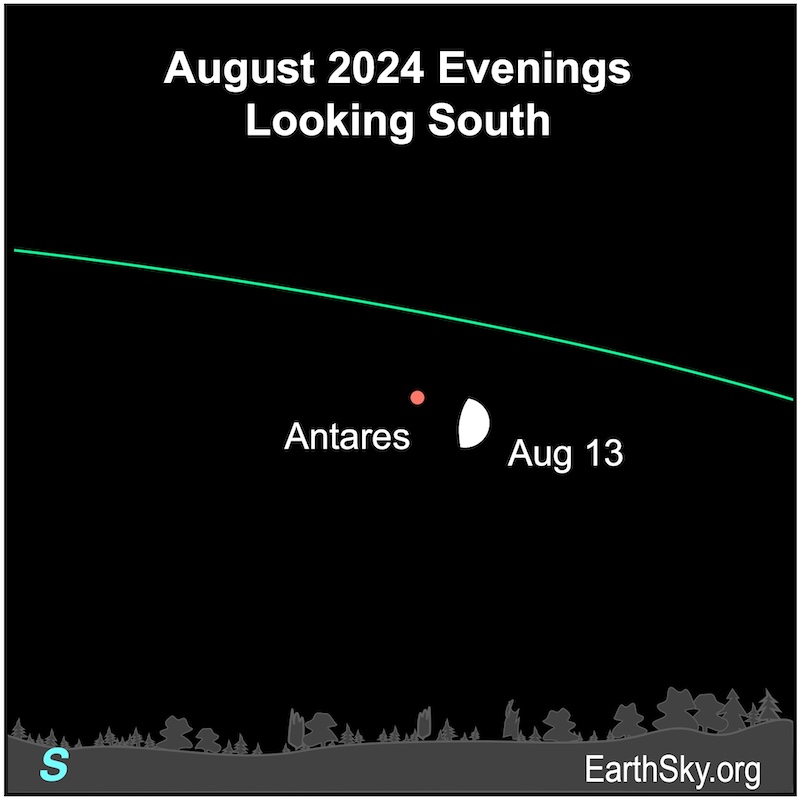
August 15 and 16 evenings: Moon near Teapot
On August 15 and 16, 2024, look for the waxing gibbous moon near the Teapot, an asterism in Sagittarius the Archer. On the evening of August 15, the moon appears close to the direction of the center of the Milky Way galaxy. You can catch the moon and the Teapot until after midnight.
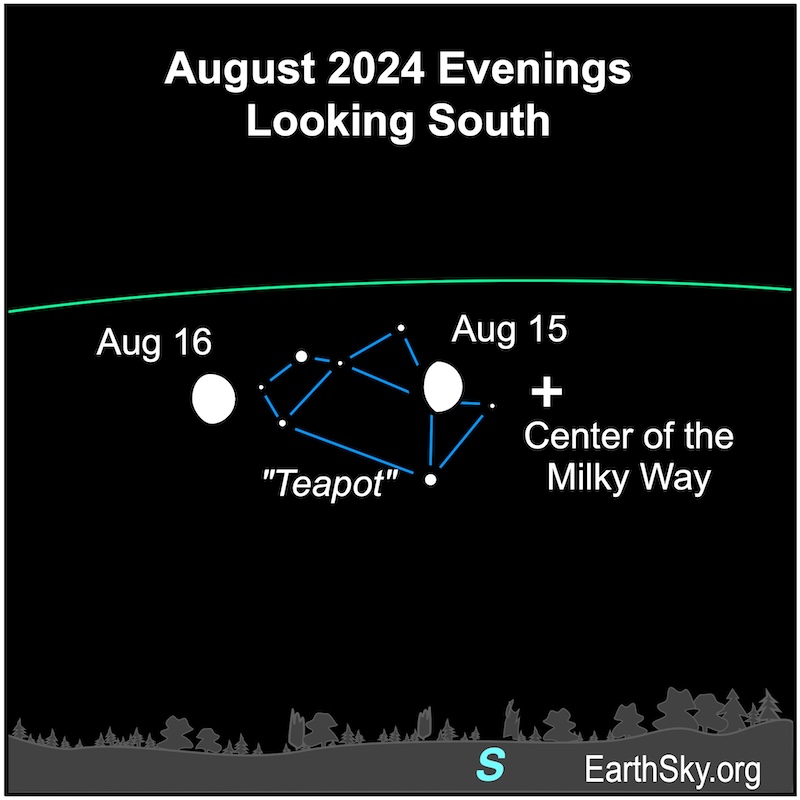
Our charts are mostly set for the northern half of Earth. To see a precise view – and time – from your location, try Stellarium Online.
August 19: Full supermoon
The moment of full moon will fall at 18:26 UTC (1:26 p.m. CDT) on August 19, 2024. A full moon rises opposite the sunset, is highest in the sky at midnight and lies low on the western horizon opposite the sunrise. This is the first of four supermoons in a row.
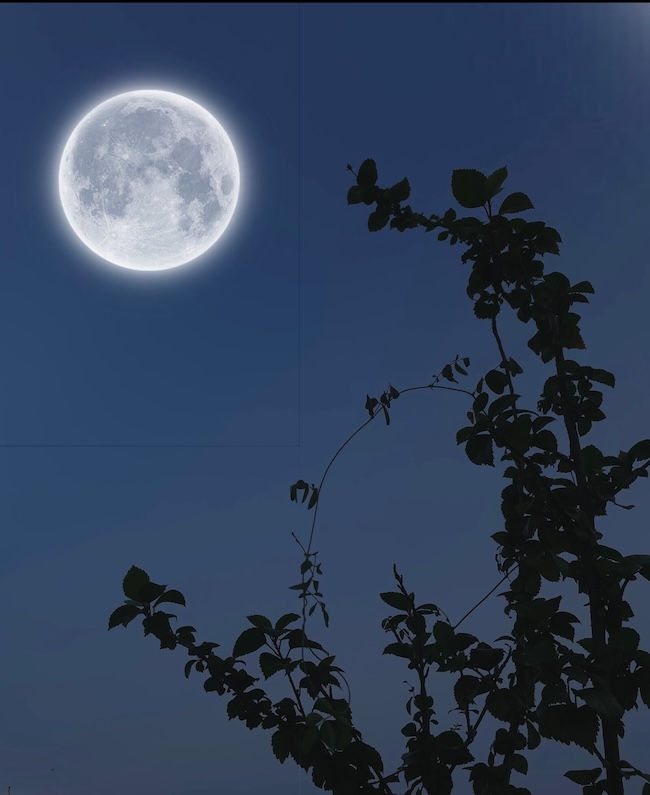
August 19: Mercury at inferior conjunction
Mercury will pass between Earth and the sun, reaching inferior conjunction at 2 UTC on August 19.
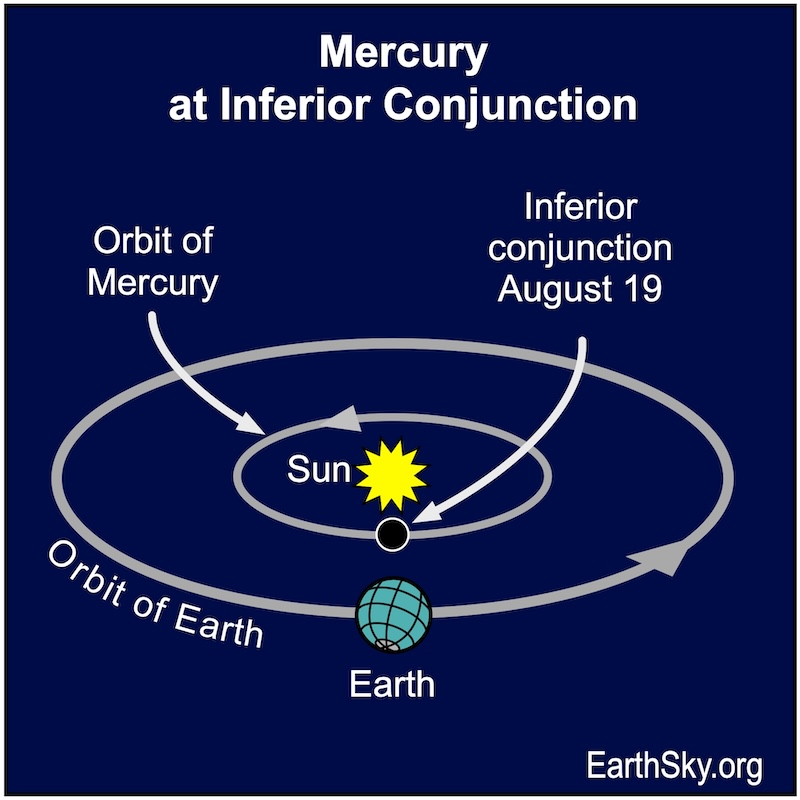
August 20 evening: Moon close to Saturn
On the evening of August 20, 2024, the waning gibbous moon will lie next to Saturn. The moon will occult – pass in front of – Saturn for observers from Latin America and the Caribbean, Africa and Europe at 3 UTC on August 21, 2024. They’ll rise around 9 p.m. local time and set after sunrise.
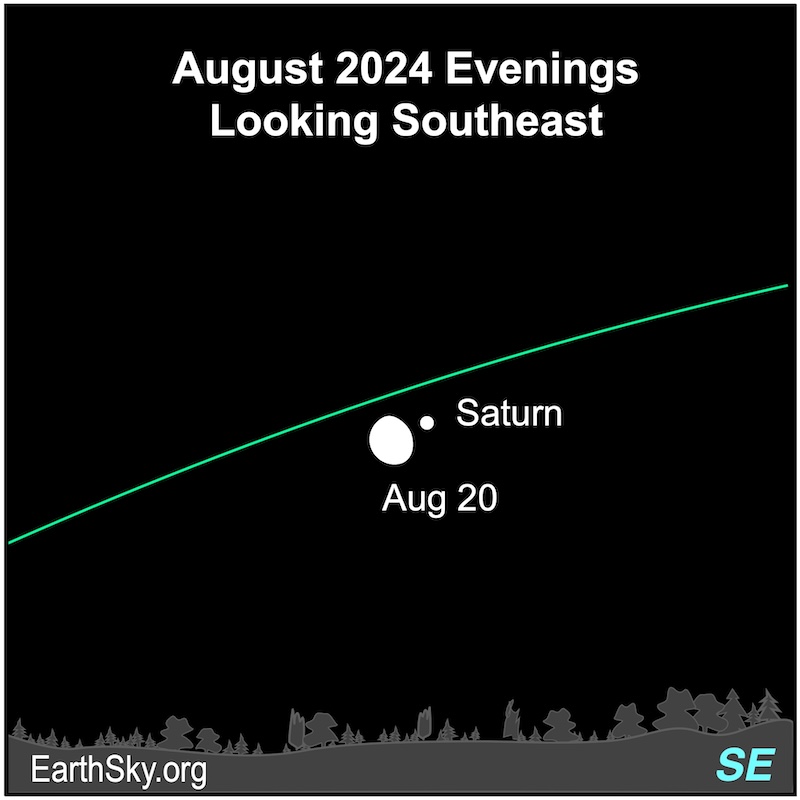
August 21: Moon reaches perigee
The moon will reach perigee – its closest point in its elliptical orbit around Earth – at 5 UTC (12 a.m. CDT) on August 21, 2024, when it’s 223,815 miles (360,196 km) away. And while this moon isn’t considered a micromoon, see the image below showing the difference between a closest moon, an average distance moon and the farthest moon.
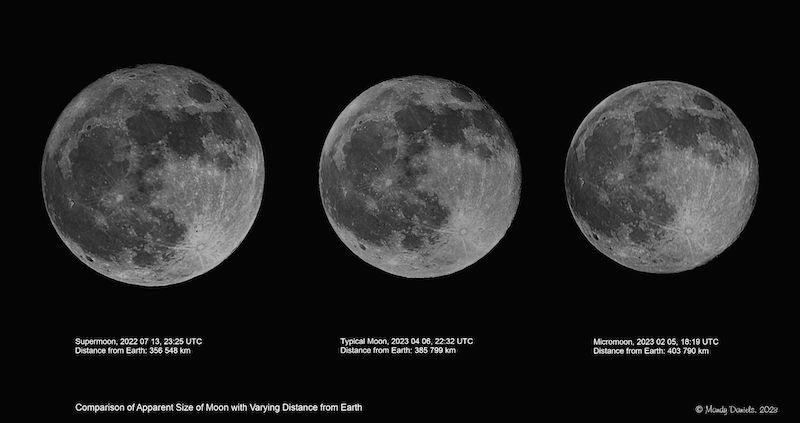
August 25 and 26 evenings: Moon close to Jupiter, Mars and Pleiades
On the morning of August 25, 2024, the 3rd quarter moon will pass the Pleiades star cluster on its way to visit the planets Jupiter and Mars. Then on the morning of August 26, the moon will lie close to Jupiter and Mars. They’ll rise several hours before dawn. Check out the color contrast between the fiery red star Aldebaran and reddish Mars.
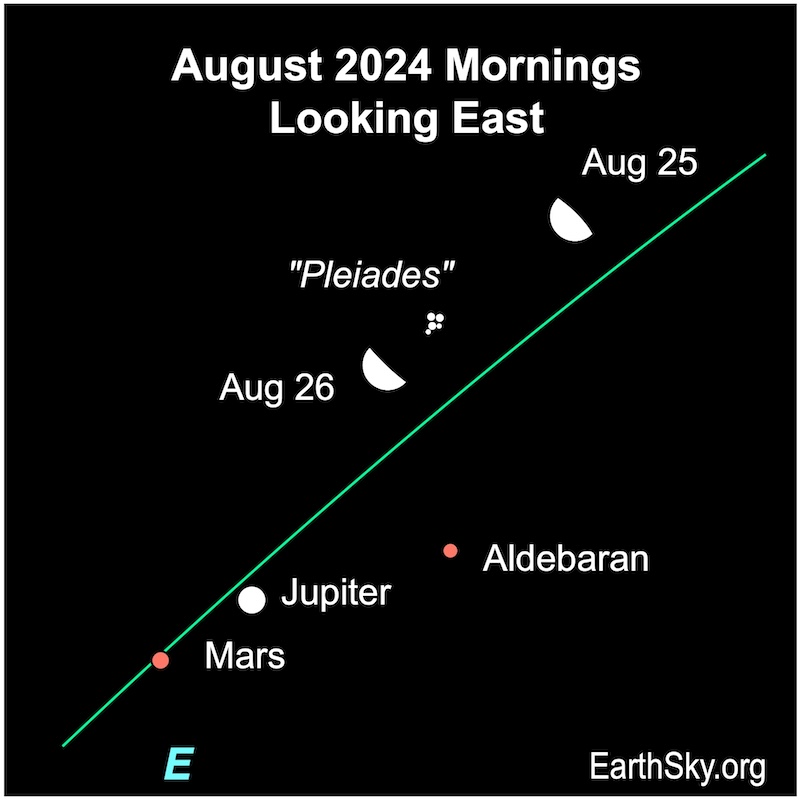
Our charts are mostly set for the northern half of Earth. To see a precise view – and time – from your location, try Stellarium Online.
August 26: Last quarter moon
The moment of last quarter moon will fall at 9:26 UTC (4:26 a.m. CDT) on August 28, 2024. It’ll rise after midnight your local time and will set around noon. Look for it high in the sky before dawn.
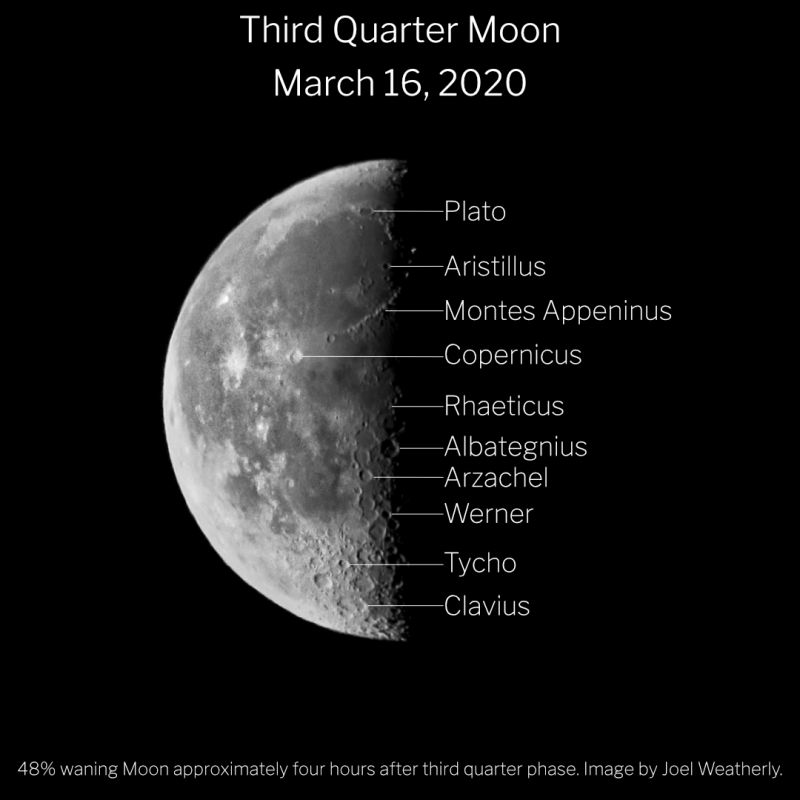
August 27 and 28 mornings: Moon hangs with Jupiter
On the mornings of August 27 and 28, 2024, the fat waning crescent moon will slide by bright Jupiter and red Mars. Have you been watching them drift apart after the recent morning conjunction? Also look for the bright stars Capella, Aldebaran and Betelgeuse. Plus the shimmering Pleiades star cluster is nearby. What a lovely sight!
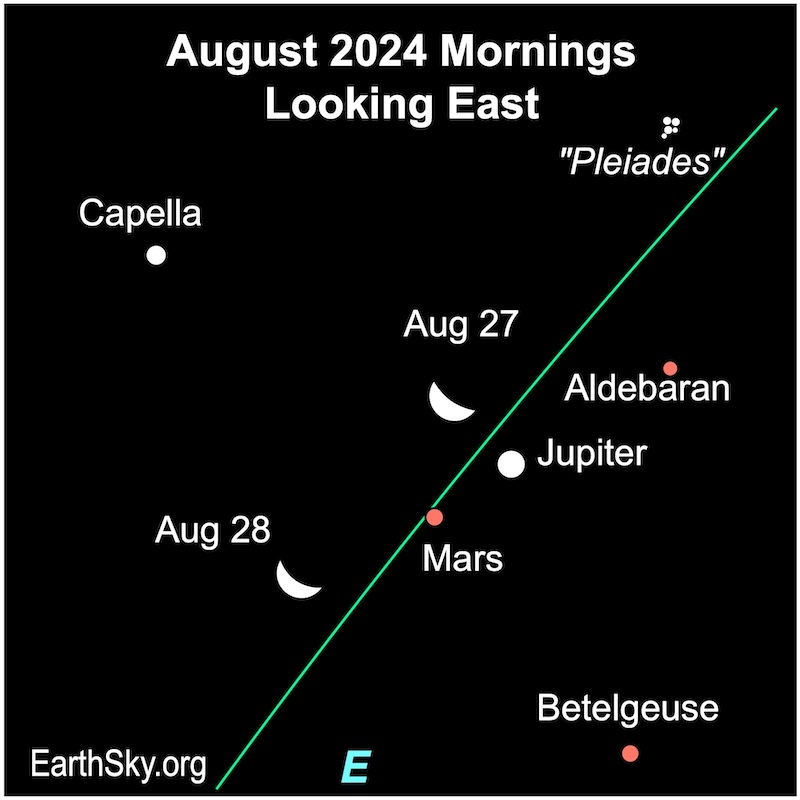
Around August 28 mornings: See 6 Planets across the sky
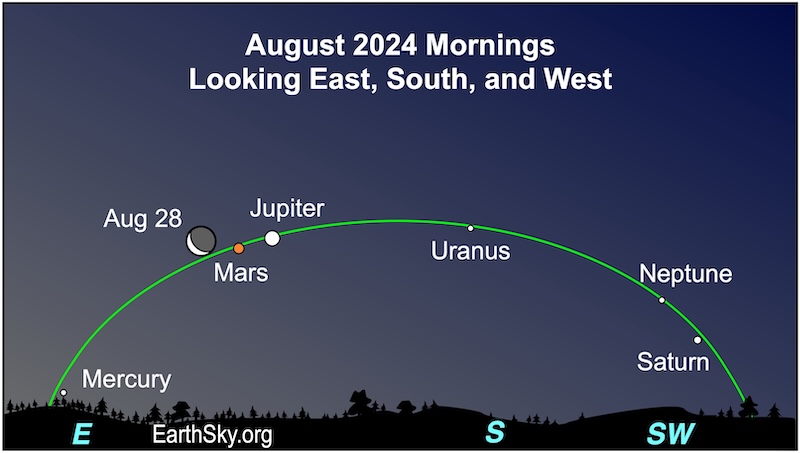
August 29 and 30 mornings: Moon and twin stars
On the mornings of August 29 and 30, 2024, in the east shortly before sunrise, the waning crescent moon will hang near the twin stars of Gemini, Castor and Pollux. The bright star Procyon of Canis Minor the lesser dog is also nearby. Can you see earthshine glowing on the moon? That’s light reflected off the Earth. How cool is that?
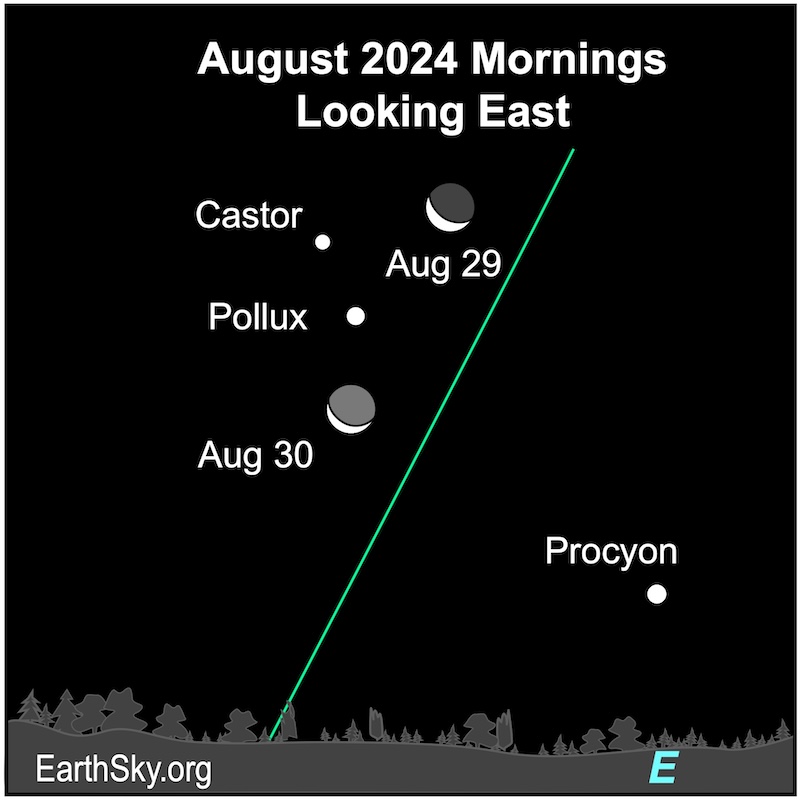
Our charts are mostly set for the northern half of Earth. To see a precise view – and time – from your location, try Stellarium Online.
August 31 morning: Moon, Castor, Pollux and Beehive
On August’s final morning, August 31, 2024, the thin waning crescent moon will lie near Castor and Pollux, the “twin” stars of Gemini. They’re named for the immortal brothers from different fathers, so they don’t really look alike. Pollux is a bit brighter and golden in color. Castor appears white. And the moon will be close to the faint Beehive star cluster. In a dark sky, the Beehive is an easy target with binoculars. They’ll rise a few hours before sunrise, so try to catch them before dawn.
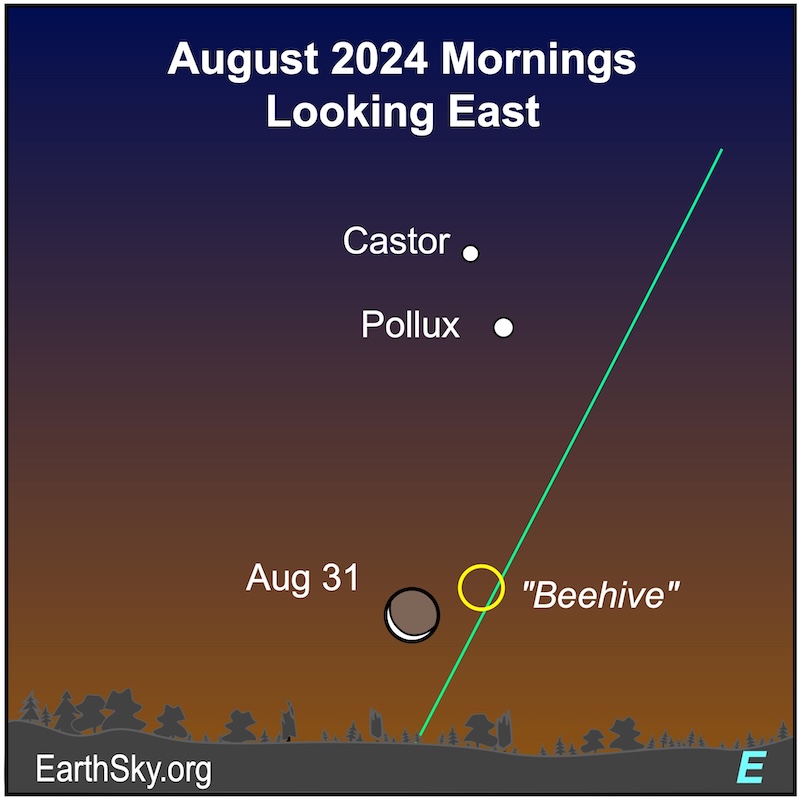
August 31 morning: Binocular view of moon and Beehive Cluster
Here’s a binocular view of the slender waning crescent moon and the Beehive star cluster on the morning of August 31. Through binoculars, you will see a few dozen of the 1,000 or so stars that are members of the Beehive.
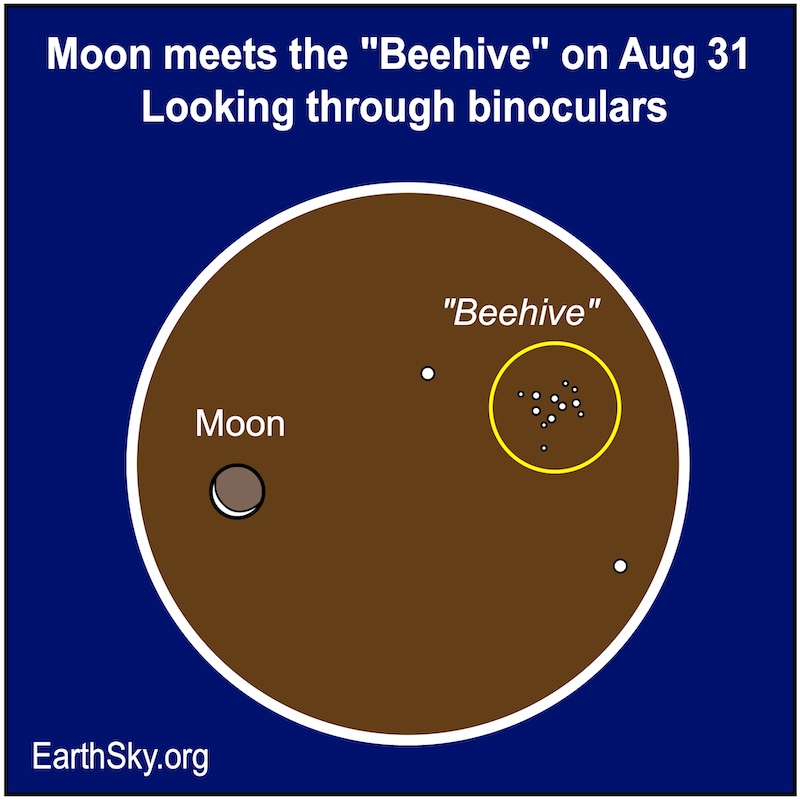
Stars and constellations overhead in July
If you’re out stargazing on any evening, look for these stars and constellations overhead in the sky.
Summer Triangle
On any evening – through December – watch for the famous Summer Triangle, an easy-to-see large pattern of three stars. It’s now ascending in the eastern sky on these July evenings.
This pattern consists of three bright stars in three separate constellations – Deneb in the constellation Cygnus the Swan, Vega in the constellation Lyra the Harp, and Altair in the constellation Aquila the Eagle.
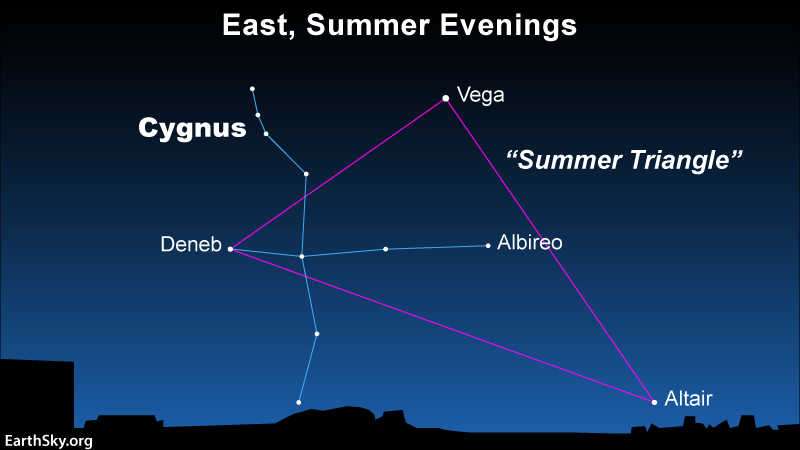
Lyra the Harp
The constellation Lyra the Harp is made of a triangle and a parallelogram. Its brightest star is Vega. Look next to it for the famous Epsilon Lyrae, a double-double star, really four stars in all.
Vega is prominent in northern summer skies, located on one corner of the Summer Triangle. Vega is magnitude 0.03, which makes it the 5th brightest star in all the sky or the second brightest star belonging to just the Northern Hemisphere. Vega is so bright because it lies just 25 light-years away.
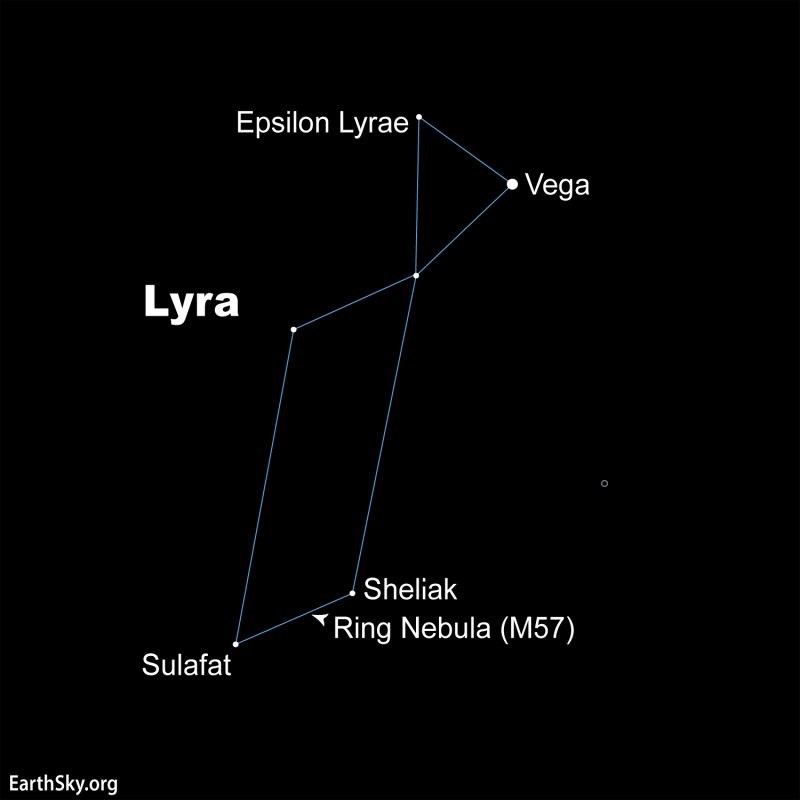
Cygnus the Swan
If you have a dark sky, it’s easy to see the edgewise view into our own galaxy – our Milky Way – spun across the heavens. As you look toward it, you’ll be gazing toward the constellation Cygnus the Swan, too. Its brightest star is called Deneb, the Swan’s Tail. And the constellation Cygnus contains one of the most beloved double stars in the sky, blue and gold Albireo.
Deneb also marks one of the corners of the famous Summer Triangle, an asterism composed of three bright stars in three different constellations.
So there’s a lot going on in this part of the sky! And no wonder, because the Swan lets you peer into the depths of the Milky Way.
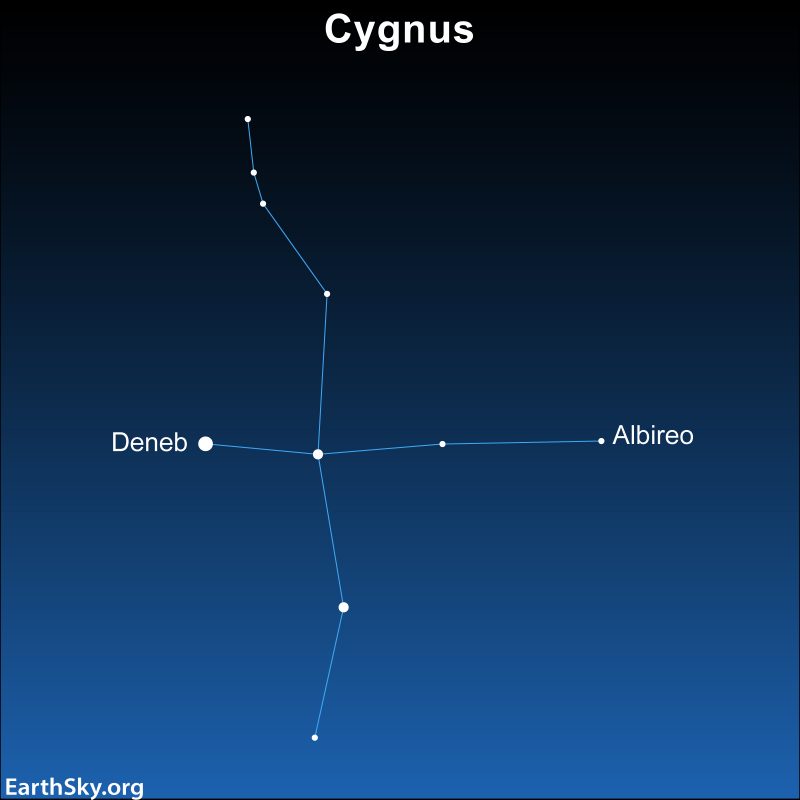
Hercules the Strongman and the Hercules Cluster
In July, look for the faint constellation Hercules the Strongman in the evening sky. Its midsection contains the easy-to-see Keystone shape (an asterism). You can find Hercules between the bright stars Vega in Lyra the Harp and Arcturus in Boötes the Herdsman. And once you find the Keystone, you can easily locate M13, the Hercules cluster.

Enjoy exploring the night sky!
Stars and constellations high in the sky during August
If you’re out stargazing on any August evening, look for these stars and constellations overhead in the sky.
Cepheus the King
The stick-house-shaped constellation Cepheus lies in the northern sky. Its star Gamma Cephei, or Errai, marks the peak of the roof of the house. And Errai is very near Polaris, the North Star. And you’ll spot the W-shaped constellation Cassiopeia nearby.
Cepheus is visible from the Northern Hemisphere every night of the year due to its close location to Polaris, the North Star.
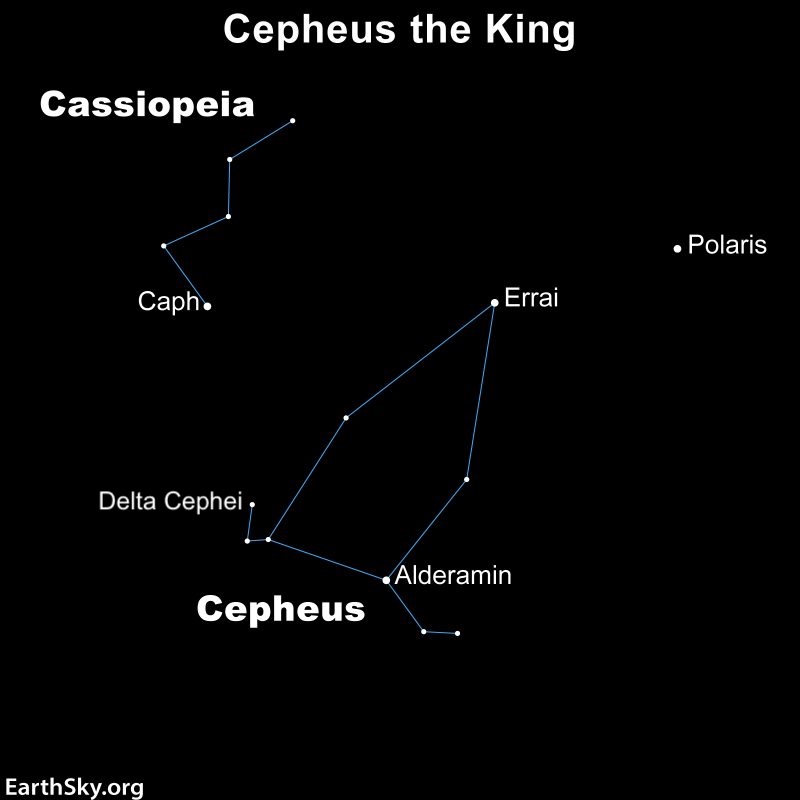
Our charts are mostly set for the northern half of Earth. To see a precise view – and time – from your location, try Stellarium Online.
The Northern Cross
The constellation Cygnus represents a graceful swan. But many also see it as a cross, and so these stars have become known as an asterism called the Northern Cross. The entire pattern fits inside a larger asterism created by the 3 bright stars Vega, Deneb and Altair: the famous Summer Triangle.
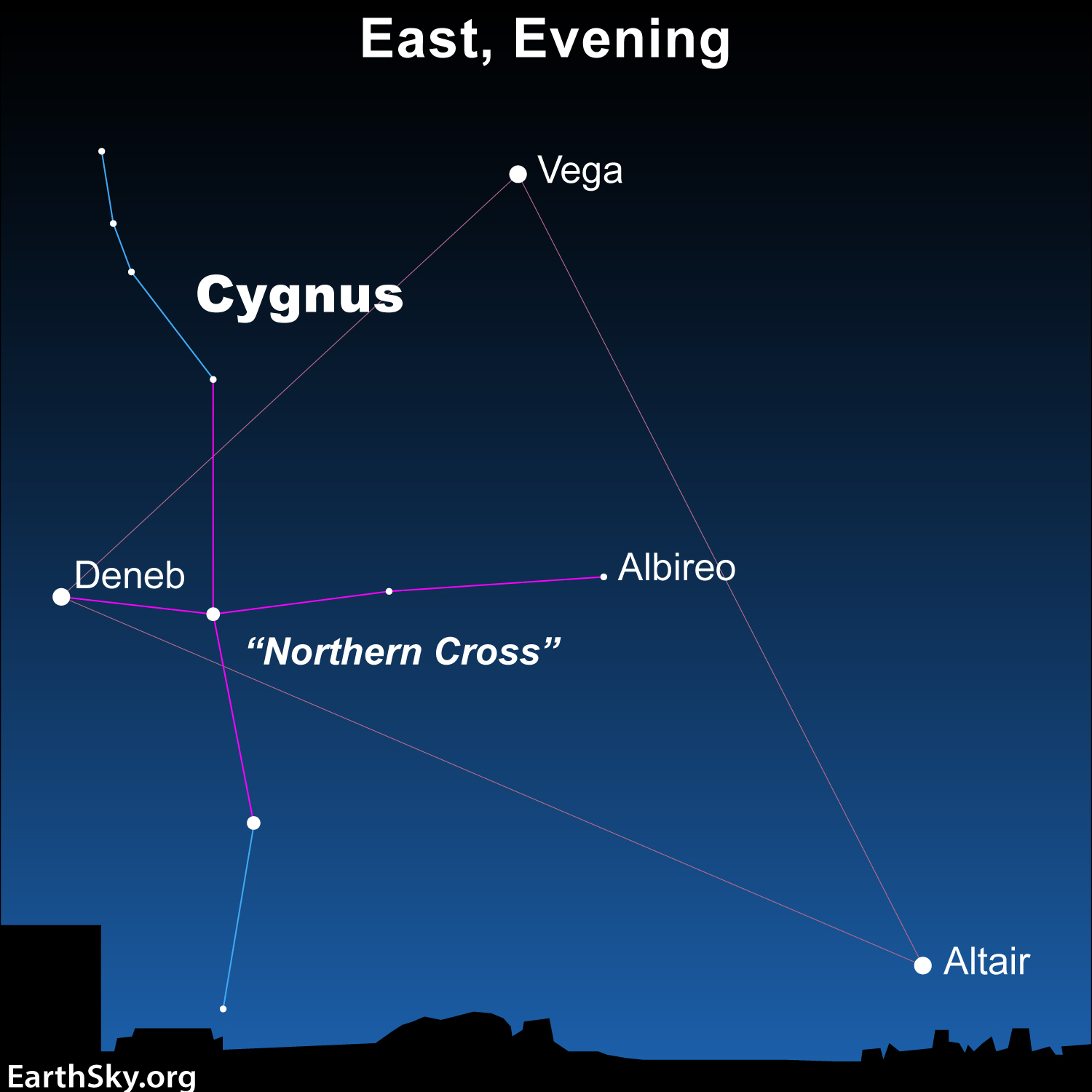
Vulpecula, Sagitta and Delphinus
Look for the Summer Triangle, a large asterism on August evenings. It consists of three bright stars in three separate constellations. These stars are Vega, Deneb and Altair.
If you can find the Summer Triangle, you can use it to locate three of the sky’s smallest constellations. They are Vulpecula the Fox, Delphinus the Dolphin and Sagitta the Arrow. All three are impossible to see from the city. But they’re lots of fun to pick out in a dark sky.
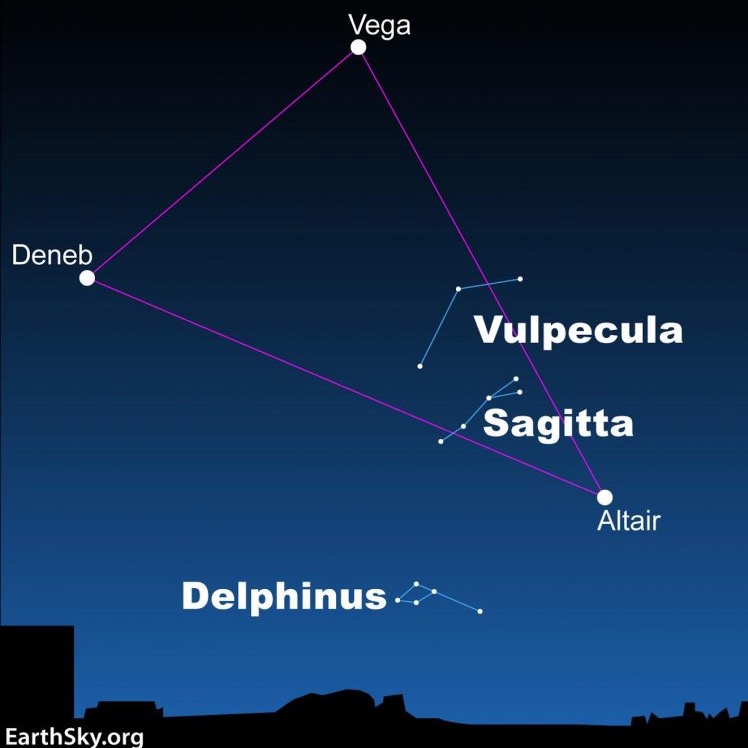
July morning planets
In July 2024, Jupiter becomes more prominent each day as it climbs out of the morning twilight. It spends the month in the constellation Taurus the Bull. It’s shining at -2.0 magnitude most of the month. The waning crescent moon will be near Jupiter on July 30. Jupiter will rise about two hours before the sun on July 1 and will rise over three hours before sunrise by month’s end. As the month goes by, Mars will be closing in on Jupiter. Jupiter and Mars will have a close conjunction on August 14, 2024. Jupiter will be brightest in December this year.
Mars will shine at 1st magnitude, and its disk will grow to 5.9 arcminutes by the end of the month. The waning crescent moon will be near Mars on the mornings of July 1 and 30, 2024. Mars will move to the constellation Taurus the Bull on July 11. It’ll rise about three hours before sunrise on July 1 and around four hours before sunrise by the end of July. Mars will be brightest in January 2205.
Also, the shimmering Pleiades star cluster appears near Mars. The bright orangish star joining the scene is Aldebaran. It’s the brightest star in the constellation Taurus the Bull.
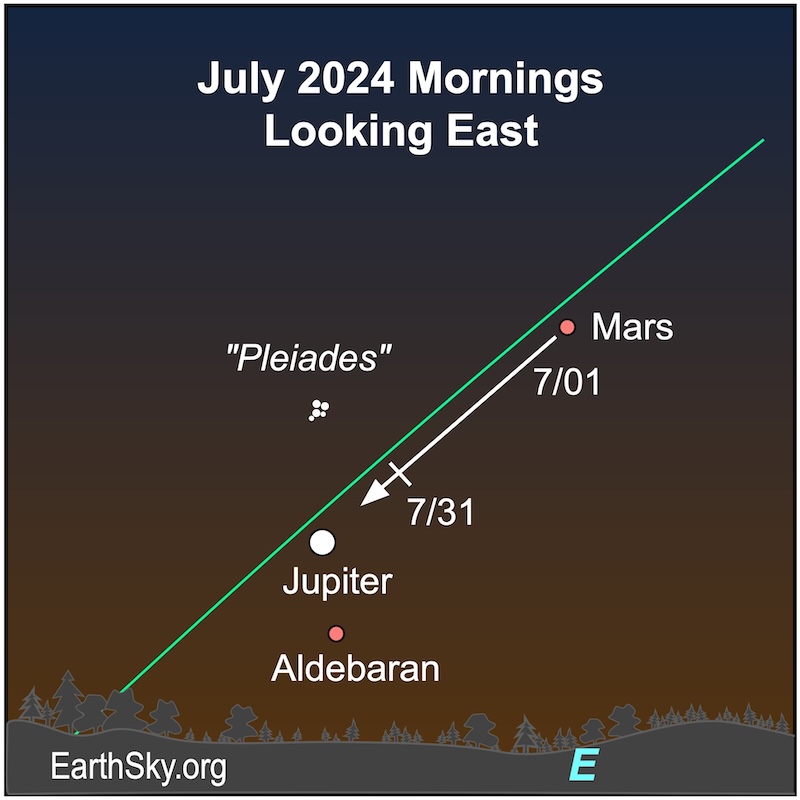
Saturn will shine around 1st magnitude in July 2024. Its ring system is closing. They’ll be edge-on in March 2025. The bright star Fomalhaut shines nearby. Saturn spends the month in the faint constellation Aquarius the Water Bearer. The moon will visit Saturn on July 24 and 25. Observers in locations including Asia and Africa will see the moon pass in front of – or occult – Saturn around 21 UTC on July 24. Saturn will rise about two hours after sunset on July 1 and will rise before 9 p.m. your local time by month’s end. Saturn will reach opposition on September 8, 2024. That’s when we fly between it and the sun.
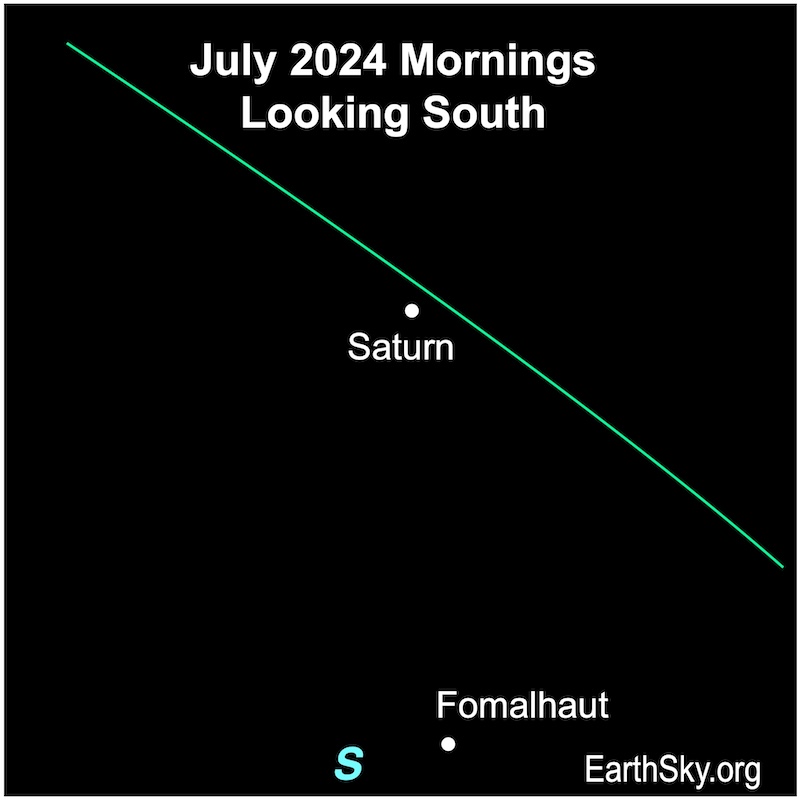
July evening planets
Mercury will shine in the evening twilight all month. Binoculars will help spot this little world. It’ll reach its greatest evening elongation on July 22, 2024, when it’s 27 degrees from the sun. It’ll be shining at magnitude -0.6 at the beginning of the month and fade to magnitude +0.3 by month’s end. This will be the best evening apparition of 2024 for Southern Hemisphere observers. On the other hand, in the Northern Hemisphere, it never gets very far above the horizon this month. The moon will hang close to Mercury on July 7. Also, Mercury will lie closer to the bright star Regulus each day.
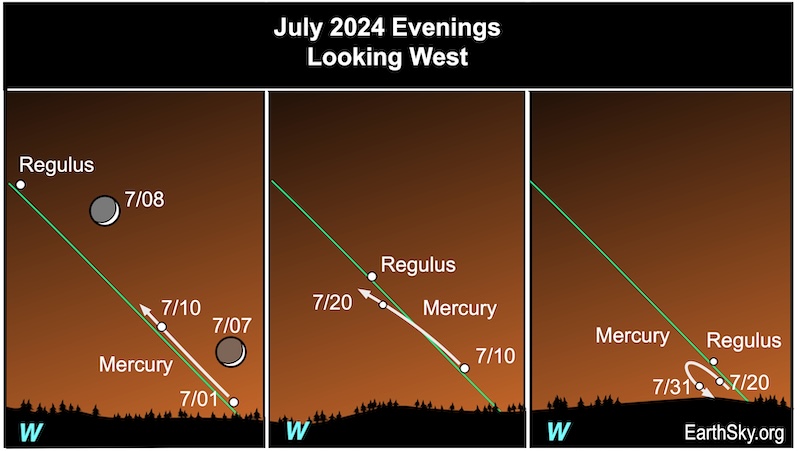
Where is Venus?
Venus is too close to the sun to be visible most of this month. It’ll emerge in the evening sky by the end of July.
Our charts are mostly set for the northern half of Earth. To see a precise view – and time – from your location, try Stellarium Online.
Visible planets in August 2024
August morning planets
Keep an eye on Jupiter and Mars, they will have a close conjunction on August 14, 2024.
Jupiter spends the month in the constellation Taurus the Bull. It’s shining at -2.0 magnitude. The waning crescent moon will hang near Jupiter on August 27. Jupiter will rise about two hours before the sun on August 1 and will rise over four hours before sunrise by month’s end. Jupiter will be brightest in December this year.
Mars will shine at 0.7 magnitude by month’s end, and its disk will grow to 6.3 arcminutes by the end of the month. The waning crescent moon will be near Mars on the mornings of August 27 and 28, 2024. Mars will lie in the constellation Taurus the Bull. It’ll rise about two hours before sunrise on August 1 and around over three hours before sunrise by the end of the month.
Also, the shimmering Pleiades star cluster is near the two planets. Plus, the bright orangish star joining the scene is Aldebaran. It’s the brightest star in the constellation Taurus the Bull.
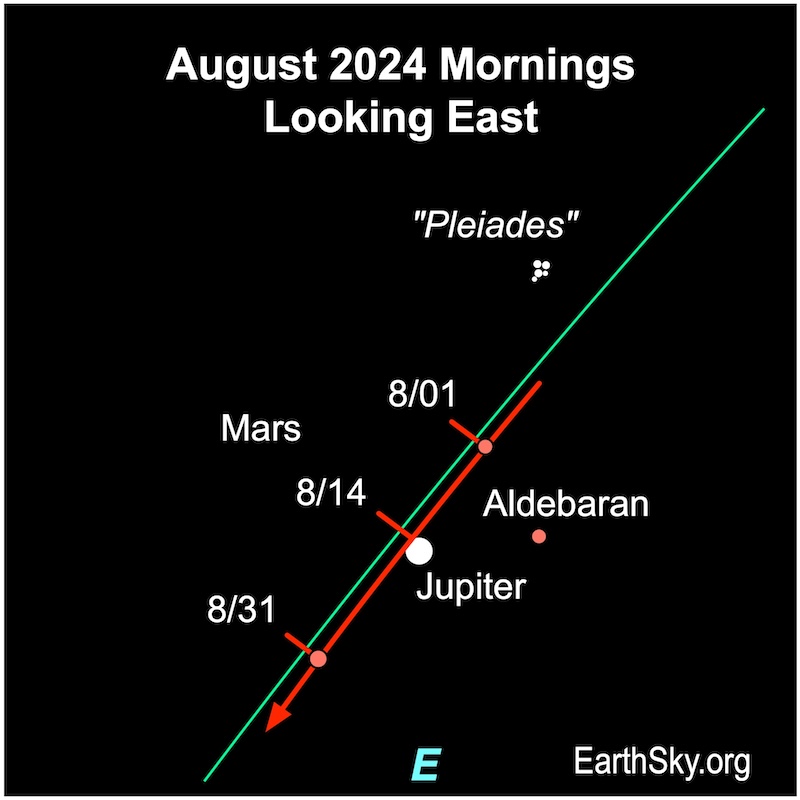
Saturn will shine around 0.8 magnitude in August 2024. Its ring system is closing. They’ll be edge-on in March 2025. Saturn spends the month in the faint constellation Aquarius the Water Bearer. The moon will visit Saturn on August 21. The moon will occult – pass in front of – Saturn for observers from Latin America and the Caribbean, Africa and Europe at 3 UTC on August 21, 2024. Saturn will rise about two hours after sunset on August 1 and will rise before 9 p.m. your local time by month’s end. Saturn will reach opposition on September 8, 2024. That’s when we fly between it and the sun.
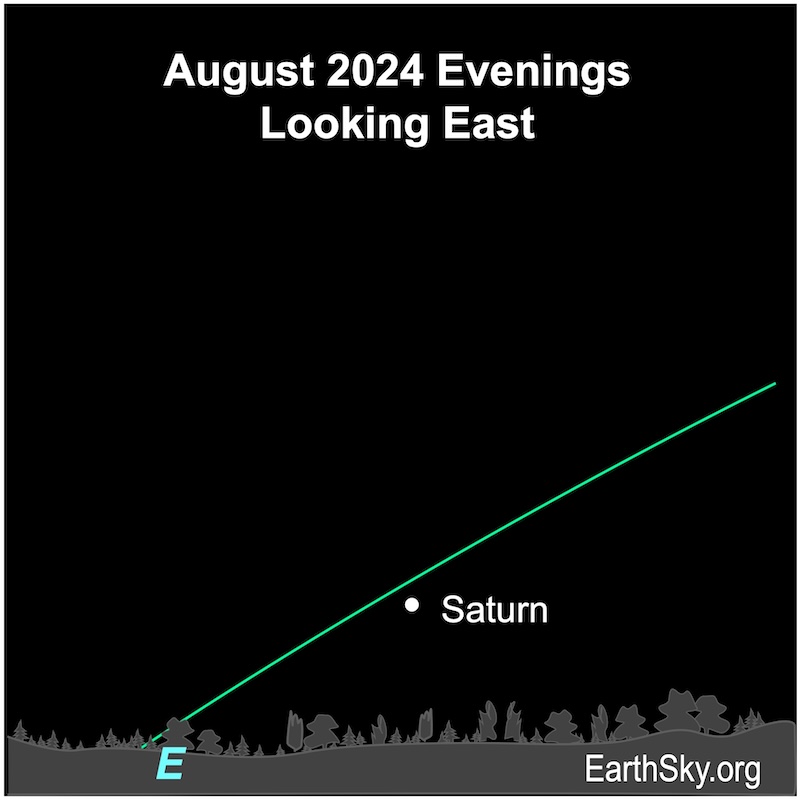
August evening planets
Brilliant Venus will be climbing out of the western evening twilight this month. Look for it very low in the west 30 minutes after sunset in August. The slender waxing crescent moon will float near it on the evening of August 5. Like Mercury, Venus will be easier to spot from the Southern Hemisphere this month.
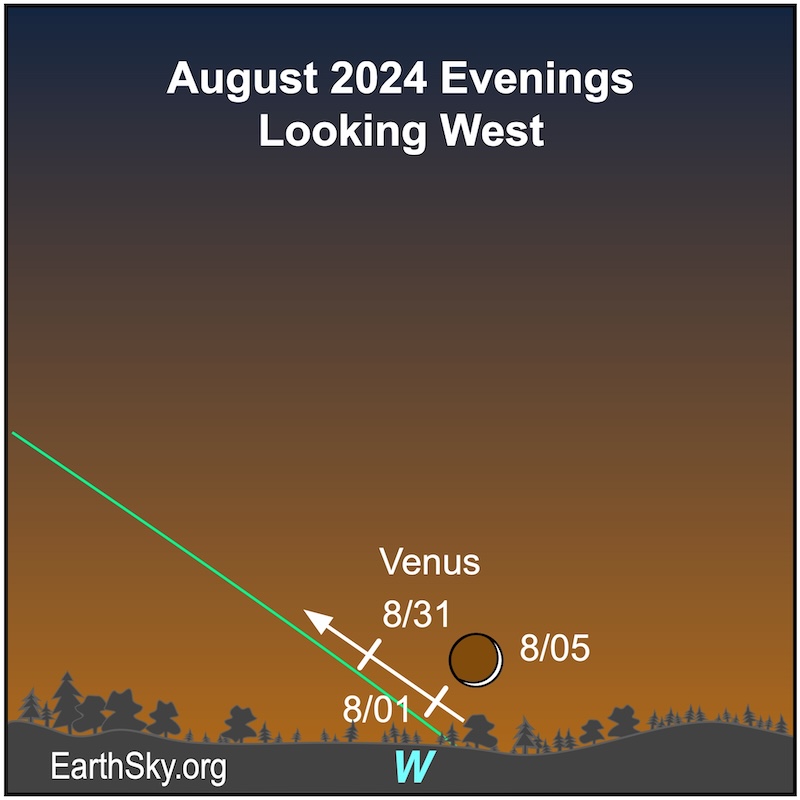
Mercury for viewers in the Southern Hemisphere: Mercury will be visible low in the west about 30 minutes after sunset in early August, quickly dimming and dropping closer to the horizon each evening. The bright planet Venus is nearby. Mercury has probably already slipped from view for those in the Northern Hemisphere. The waxing crescent moon will lie near Mercury on August 5 and 6. Mercury will move back to the morning sky at the end of August.
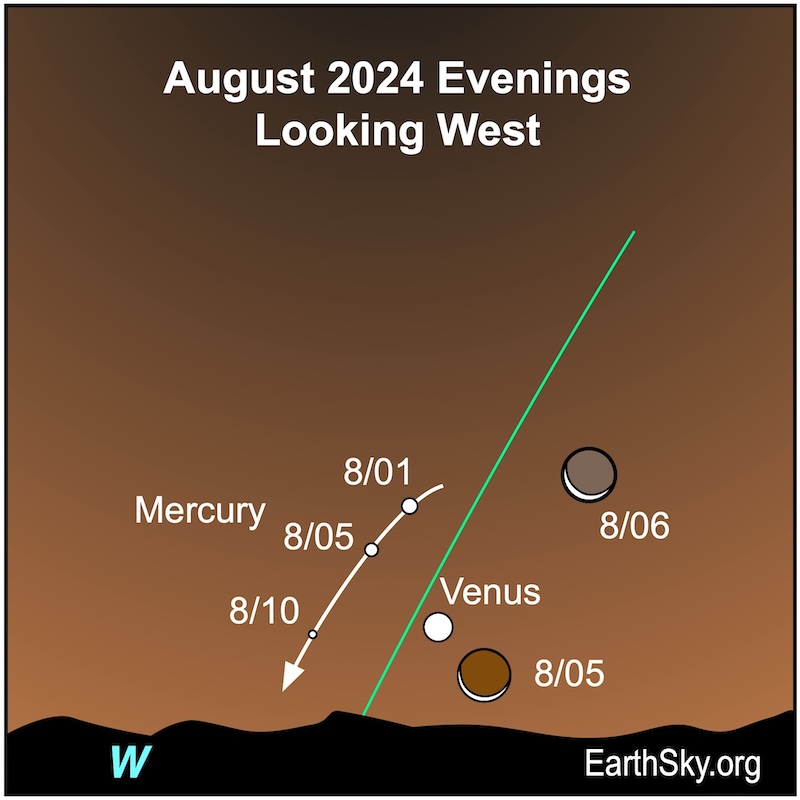
Sky dome maps for visible planets and night sky
The sky dome maps come from master astronomy chart-maker Guy Ottewell. You’ll find charts like these for every month of 2024 in his Astronomical Calendar.
Guy Ottewell explains sky dome maps
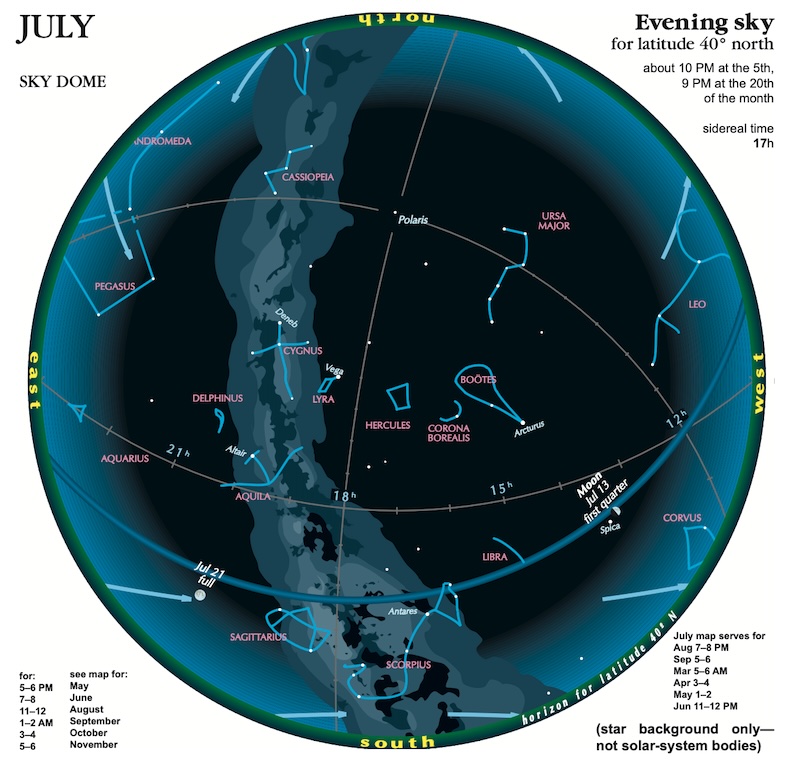

Heliocentric solar system visible planets and more
The sun-centered charts come from Guy Ottewell. You’ll find charts like these for every month of 2024 in his Astronomical Calendar.
Guy Ottewell explains heliocentric charts.


Some resources to enjoy
For more videos of great night sky events, visit EarthSky’s YouTube page.
Don’t miss anything. Subscribe to daily emails from EarthSky. It’s free!
Visit EarthSky’s Best Places to Stargaze to find a dark-sky location near you.
Post your own night sky photos at EarthSky Community Photos.
See the indispensable Observer’s Handbook, from the Royal Astronomical Society of Canada.
Visit Stellarium-Web.org for precise views from your location.
Almanac: Bright visible planets (rise and set times for your location).
Visit TheSkyLive for precise views from your location.

Bottom line: Visible planets and night sky guide for July 2024. It’s summer meteor time! The Delta Aquariid meteors ramble across the sky for weeks from late July through early August. They blend in with the famous Perseid meteor show. Follow these tips to optimize your chances of seeing a great meteor display.











